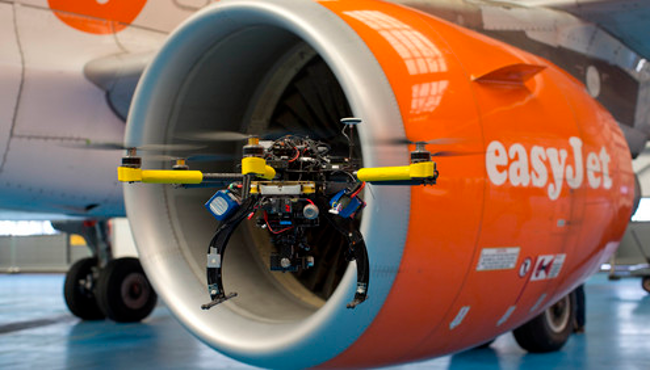This article is more than 1 year old
Ex-US Navy fighter pilot MIT prof: Drones beat humans - I should know
'Missy' Cummings on UAVs, smartcars and dying from boredom
Automation to cure automation apathy
Some uses of drones are really, er, pie in the sky efforts. A North Yorkshire startup called New Wave Energy has come up with a concept to deploy a network of drones at a high altitude to harvest solar and wind energy.
The company claims it has developed the foundational technology to fly drones in networked clusters connected wirelessly to each other. The drones would be outfitted with solar panels and turbines to harvest solar and wind energy, effectively creating a high-altitude power plant. To get the energy for reuse on the ground, New Wave plans to install antenna arrays either on land or on offshore installations to receive the electromagnetic waves transmitted from the drones.

Cummings: less collateral damage with a drone
than a human. Photo: Duke University
Amazon and New Wave Energy seem out there, but what about easyJet?
Drones are helping the carrier inspect its fleet of aircraft, working harder and in more challenging conditions than is possible for their human counterparts.
For easyJet, cutting back on the time it takes to service and provide maintenance for the company’s aircraft fleet is the key driver to the company’s investment in deploying drones, easyJet's head of powerplant and fleet transition Gary Smith told The Reg.
“One of the things we suffer with quite regularly is disruption due to aircraft damage — an act of god, lighting or hail, or it also could be ground damage caused by a truck running into an aircraft,” he said.
“For a big airline like us, we see those type of events at least once a day, quite regularly. They could cause significant down time while we carry out detailed inspections.”
These inspections entail maintenance workers pok[ing] around, sometimes with equipment, to visually inspect the aircraft. Often this calls for them to be in uncomfortable or even potentially dangerous positions as they examine difficult-to-reach parts of the plane, such as high up on the tail fin or in places with limited space.
We’ve got so much automation we’ve got a problem with people being incredibly bored, problems with sleeping, being distracted,” Cummings said. “We’re trying to figure out how to design systems to potentially intervene
“We were looking at ways to speed that up and also remove the need for engineers to access difficult parts of aircraft,” he said. “That’s where the use of drones or some kind of robotic equipment that could fly independently or be controlled remotely [would be useful],” Smith said.
Safer for humans
Taking humans out of the equation has benefits in really high-risk scenarios.
Drones are being developed by Oklahoma State University researchers to fly into the heart of super-cell storms to collect data to help improve tornado forecasting – demonstrating that UAVs are not just for military engagement or parcel dropoffs but can be used for numerous other applications.
Another reason for removing humans is to eliminate the boredom factor, and the dangers this can produce. But, in an twist of irony, the systems that are enabling remote control are developing to a point where boredom can creep back in and where accidents and incidents are as possible as if a person was in the pilot’s seat. One of the main focuses of some of Cummings’ work now is to mitigate the boredom factor in piloted systems — technology that is applicable in both automobiles and aircraft — so the humans driving these vehicles don’t fall asleep at the wheel, so to speak.

easyJet's UAVs get into places that human plane inspectors cannot reach
“We’ve got so much automation we’ve got a problem with people being incredibly bored, problems with sleeping, being distracted,” Cummings said. “We’re trying to figure out how to design systems to potentially intervene; for example, if you’re a pilot, the plane can take off and take over so you don’t crash.”
Drone car crash test dummies
Crashing drones is one thing, but what about cars? Drones tend to come down comparatively rarely and in relatively unpopulated areas.
But what happens if driverless cars become viable?
Smart cars have the driving force of internet search giant and ads slinging Google behind them and being investigated by car giant Ford in association with academia. Unlike Google, Ford has the power to make driverless cars actually happen should the technology pan out.
Ford is working with the University of Michigan on the idea, which this summer announced construction of a 32-acre smartcar test facility comprising a city centre and a four-lane highway. The University is working to develop sensors and mapping technology for Ford Fusion hybrid.
Cummings work is now starting turn to unmanned cars.
"It is a potential critical safety issue that people will get very bored with a pretty good (but not perfect) driverless car, and so how to keep the driver in the loop at just the right time is going to be pretty important,” Cummings said.
“We are working right now on how to detect when a person is bored or zoned out so that the car knows the human is not a reliable input.” ®
